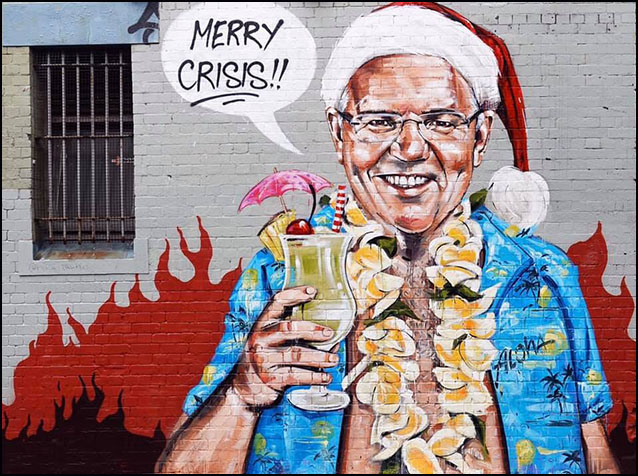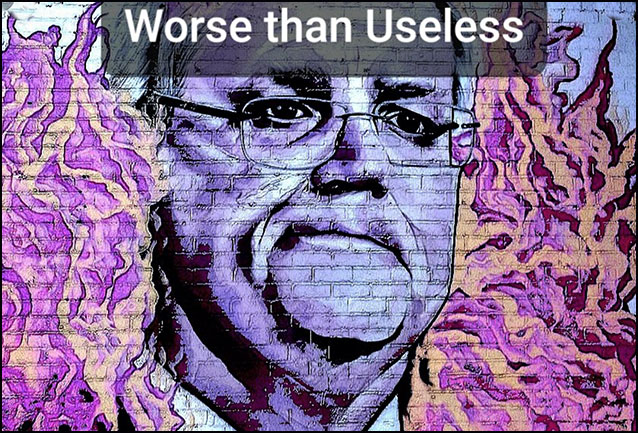1008 Our PM met with the people's wrath
NewScientist:
Australian government report predicted severe wildfires 11 years ago ...
read the whole story below.
Vox:
As Australia burns, its leaders are clinging to coal. Australia is the world’s largest coal exporter, but its government is downplaying its contributions to climate change. Read the story here.




NewScientist
Australian government report predicted severe wildfires 11 years ago
A 2008 report commissioned by the Australian government predicted that climate change would cause the fire season to start earlier and be more intense after about 2020 OUTSIDE Batlow in New South Wales, the scorched remains of wildlife and livestock lie pressed against fences, where they tried in vain to escape the flames that ripped through the area on 4 January. Along with the other billion-or-so other animals that have already perished in Australia’s worst wildfires on record, they will be buried in mass graves dug by the army.
Australians, myself included, are in a state of shock. At least 24 people have died, more than 2000 homes have been gutted, and 8 million hectares – an area the size of Scotland – have burned. For months now, the brown and red skies and smell of smoke have been a constant reminder of the tragedy unfolding around us.
The fires are being driven by record-breaking hot, dry conditions, which make vegetation more likely to catch fire when exposed to ignition sources like lightning strikes or discarded cigarettes. On 8 January, the Bureau of Meteorology announced that 2019 was both Australia’s driest and warmest year on record. On 18 December, the country had its hottest ever single day, when the average maximum temperature reached 41.9°C.
Despite these extremes, the Australian government has acted almost as if nothing unusual is happening. In November, deputy prime minister Michael McCormack told ABC Radio that “we’ve had fires in Australia since time began”. He dismissed the role of climate change in the current fires as the “ravings of some pure, enlightened and woke capital-city greenies”.
But Sarah Perkins-Kirkpatrick at the University of New South Wales says there is no doubt that climate change is a driving factor. “We can certainly say it has contributed to the length and severity of this fire season,” she says. In 2008, a report commissionedby the Australian government predicted that from about 2020, global warming would cause Australia’s fire seasons to start earlier, end later and be more intense. “We knew this was going to happen,” says Perkins-Kirkpatrick.
“We can certainly say climate change is a driving factor. We knew this was going to happen”
Two large-scale climate phenomena are also contributing to the conditions underpinning the fires, says Andrew Watkins at Australia’s Bureau of Meteorology. The Indian Ocean Dipole (IOD) has pushed warm water away from Australia towards Africa, leading to drought. And the Southern Annular Mode (SAM) has driven hot, dry winds from Australia’s desert interior towards its east coast and fanned fires in New South Wales and Victoria – the south-eastern states that have been worst hit.
These two phenomena have coincided in Australia in the past, but never for this long in recorded history, says Watkins. Add in the extra 1°C of warming that Australia has experienced since 1910 and you get a dangerous mix, he says.
The fires started in September, a month earlier than Australia’s official fire-danger season, which runs from October until the end of March. They have already burned through a greater area than the 2018 California wildfires and the 2019 Amazon fires combined, and torn through rainforests in northern New South Wales and southern Queensland that have historically been too wet to burn.
The sheer intensity of the fires has caused them to generate their own storm clouds, called pyrocumulonimbus, which can spit out lightning that starts more fires. Former New South Wales fire and rescue commissioner Greg Mullins wrote in November that he had rarely seen fire-generated thunderstorms in his 47 years of fighting fires, but now they are occurring regularly.
It is also now common to see my fellow Sydneysiders wearing gas masks on the way to work. On 1 January, Canberra’s air quality was the worst of any major city in the world.
The fires have taken a huge toll on Australia’s unique wildlife. Chris Dickman at the University of Sydney estimates that 1.3 billion mammals, birds and reptiles have died in the fires. Flying animals like birds and bats and fast-moving animals like kangaroos may initially have been able to escape the flames, but probably died soon afterwards because of the difficulty of finding food, water and shelter in the blackened landscape, says Dickman.
“We also know that invasive species like cats and foxes quickly move in after a fire goes through and pick off small native animals, so it’s really grim,” he says.
Dickman has particularly grave fears for species like the eastern bristlebird, long-footed potoroo and silver-headed antechinus, which are already endangered and live almost exclusively in fire-affected areas. They may have been wiped out altogether, he says.
Australia’s prime minister, Scott Morrison, has been heavily criticised for ignoring a meeting request from 23 former fire and emergency service leaders early last year. They wanted to warn him of the risk of a catastrophic looming fire season.
Morrison has also refused to ramp-up Australia’s greenhouse emissions reduction targets, saying in a press conference on 2 January that the government needs to balance a “vibrant and viable economy” with a “vibrant and sustainable environment”. According to 2019 figures, 93 per cent of Australia’s energy comes from fossil fuels, compared with the 80 per cent average for countries in the Organisation for Economic Co-operation and Development. Without a big shift to renewable energy, the country is on track to miss its 2030 Paris climate deal target.
As New Scientist went to press, dozens of fires continued to burn in New South Wales and Victoria, but light rain and cooler conditions since 5 January had helped firefighters partially contain them. None were burning at emergency levels, but there were concerns that forecast warmer weather could soon cause conditions to deteriorate again.
“Typically, in southern Australia, the hottest weeks are at the end of January and in early February, so we haven’t even hit our hottest period yet,” says Watkins.
Shifts in the IOD and SAM climate patterns suggest that the hot, dry conditions should ease by March or April, says Watkins. We don’t know when they will return, but modelling suggests that climate change will make such IOD events more common, he says.
When the fires are finally extinguished, it will be a long road to recovery. For many Australians, it is clear that these fires aren’t business as usual. For me, that realisation came as ash rained down on the face of my infant son at a Sydney beach. On social media, on the radio, at the pub, people are finally talking about what we need to do about climate change. If that pressures the government into real action, it will be one small consolation.